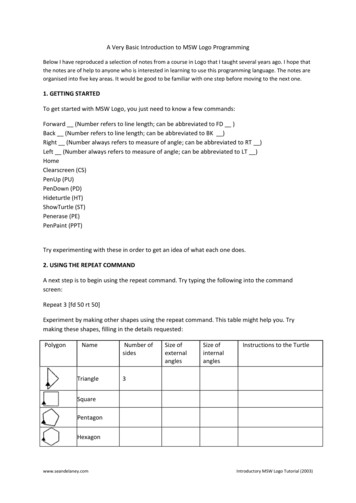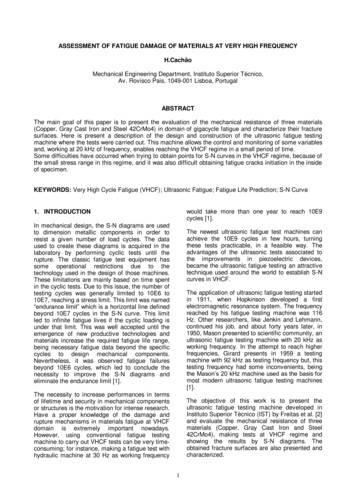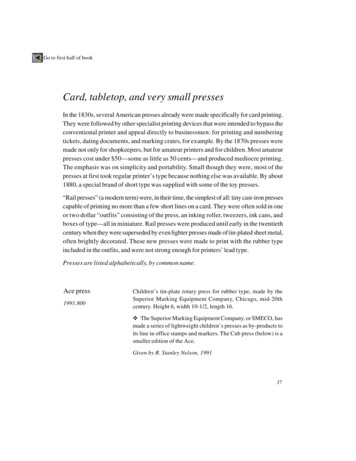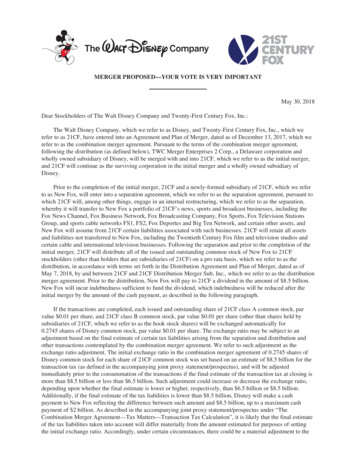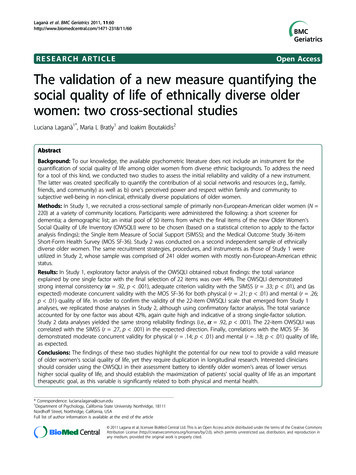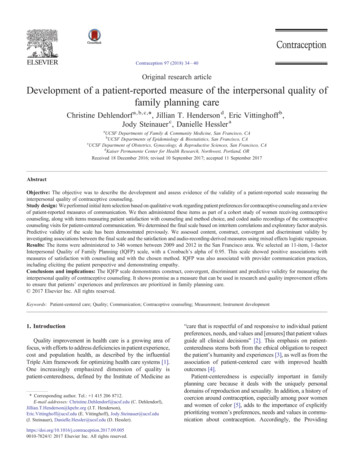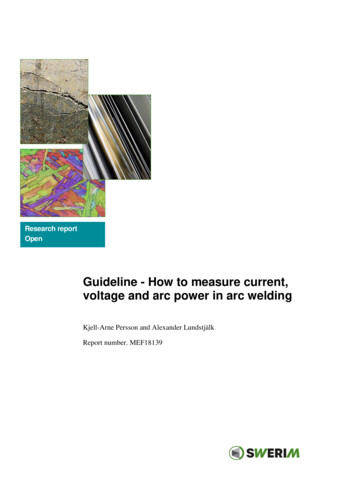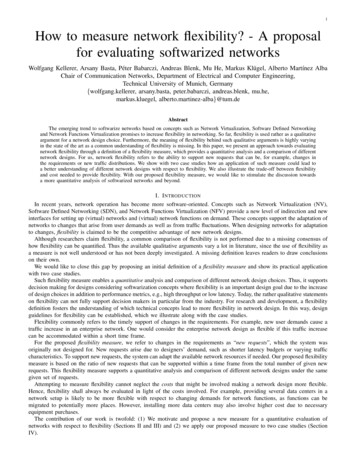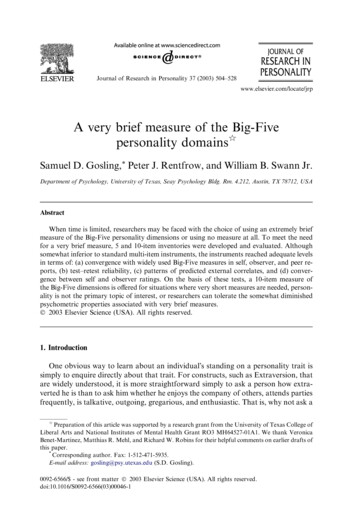
Transcription
JOURNAL OFRESEARCH INPERSONALITYJournal of Research in Personality 37 (2003) 504–528www.elsevier.com/locate/jrpA very brief measure of the Big-Fivepersonality domainsqSamuel D. Gosling,* Peter J. Rentfrow, and William B. Swann Jr.Department of Psychology, University of Texas, Seay Psychology Bldg. Rm. 4.212, Austin, TX 78712, USAAbstractWhen time is limited, researchers may be faced with the choice of using an extremely briefmeasure of the Big-Five personality dimensions or using no measure at all. To meet the needfor a very brief measure, 5 and 10-item inventories were developed and evaluated. Althoughsomewhat inferior to standard multi-item instruments, the instruments reached adequate levelsin terms of: (a) convergence with widely used Big-Five measures in self, observer, and peer reports, (b) test–retest reliability, (c) patterns of predicted external correlates, and (d) convergence between self and observer ratings. On the basis of these tests, a 10-item measure ofthe Big-Five dimensions is offered for situations where very short measures are needed, personality is not the primary topic of interest, or researchers can tolerate the somewhat diminishedpsychometric properties associated with very brief measures.Ó 2003 Elsevier Science (USA). All rights reserved.1. IntroductionOne obvious way to learn about an individualÕs standing on a personality trait issimply to enquire directly about that trait. For constructs, such as Extraversion, thatare widely understood, it is more straightforward simply to ask a person how extraverted he is than to ask him whether he enjoys the company of others, attends partiesfrequently, is talkative, outgoing, gregarious, and enthusiastic. That is, why not ask aqPreparation of this article was supported by a research grant from the University of Texas College ofLiberal Arts and National Institutes of Mental Health Grant RO3 MH64527-01A1. We thank VeronicaBenet-Martinez, Matthias R. Mehl, and Richard W. Robins for their helpful comments on earlier drafts ofthis paper.*Corresponding author. Fax: 1-512-471-5935.E-mail address: gosling@psy.utexas.edu (S.D. Gosling).0092-6566/ - see front matter Ó 2003 Elsevier Science (USA). All rights reserved.doi:10.1016/S0092-6566(03)00046-1
S.D. Gosling et al. / Journal of Research in Personality 37 (2003) 504–528505person one direct question about a trait rather than many questions about the multiple, narrow components that comprise the trait?The widely accepted answer is that, all things being equal, long instruments tendto have better psychometric properties than short instruments. However, the costsassociated with short instruments are not always as great as is feared (Burisch,1984a, 1984b, 1997). More important, there are some instances when short instruments permit research that would not be possible using long instruments.1.1. Why are short instruments needed?In an ideal world, personality researchers would have sufficient time and resourcesto exploit the superior content validity and reliability of well-established multi-iteminstruments. Unfortunately, circumstances are often not ideal and researchers maybe faced with a stark choice of using an extremely brief instrument or using no instrument at all. For example, one Internet-based study used a single-item measureto obtain ratings of self-esteem from participants who would be unlikely to dwellat the website long enough to complete a multi-item questionnaire (Robins, Trzesniewski, Tracy, Gosling, & Potter, 2002). Studies that require participants to ratethemselves and multiple others on several occasions may also profit from the useof short scales. In one longitudinal study of interpersonal perceptions, participantswere required to rate several other group members on several traits on several occasions (Paulhus & Bruce, 1992); multi-item scales would have burdened participantsexcessively so single-item measures were used. Other useful applications for short instruments include large-scale surveys, pre-screening packets, longitudinal studies,and experience-sampling studies (Robins, Hendin, & Trzesniewski, 2001a).Although single-item scales are usually psychometrically inferior to multiple-itemscales, single-item measures do have some advantages. In developing a single-itemmeasure of self-esteem, Robins et al. (2001a) noted that single-item measures‘‘. . .eliminate item redundancy and therefore reduce the fatigue, frustration, andboredom associated with answering highly similar questions repeatedly’’ (p. 152; alsosee Saucier, 1994). Indeed, Burisch (1984b, 1997) showed that short and simple depression scales can be just as valid as long and sophisticated scales. For example, selfand peer reports converged just as strongly for a truncated 9-item depression scale(r ¼ :54) as for the full 50-item scale (r ¼ :51). BurischÕs findings suggest that thesupposed psychometric superiority of longer scales does not always translate intopractice. If the psychometric costs of using short scales are not as steep as mightbe expected, their relative efficiency make them a very attractive research tool. Thewidespread use of single-item measures is a testimony to their appeal. Single-itemmeasures have been used to assess such constructs as life-satisfaction (Campbell,Converse, & Rodgers, 1976), subjective well-being (Diener, 1984; Sandvik, Diener,& Seidlitz, 1993), affect (Russell, Weiss, & Mendelsohn, 1989), cultural/ethnic identity (Benet-Mart ınez, Leu, Lee, & Morris, 2002), relationship intimacy (Aron, Aron,& Danny, 1992), attachment style (Hazan & Shaver, 1987), intelligence (Paulhus,Lysy, & Yik, 1998), and self-esteem (Robins, Tracy, Trzesniewski, Potter, & Gosling,2001b).
506S.D. Gosling et al. / Journal of Research in Personality 37 (2003) 504–5281.2. Previous Big-Five instrumentsIn this report, we evaluate new 5 and 10-item measures of the Big-Five personalitydimensions. The Big-Five framework enjoys considerable support and has becomethe most widely used and extensively researched model of personality (for reviews,see John & Srivastava, 1999, and McCrae & Costa, 1999), although it has not beenaccepted universally (Block, 1995).The Big-Five framework is a hierarchical model of personality traits with fivebroad factors, which represent personality at the broadest level of abstraction. Eachbipolar factor (e.g., Extraversion vs. Introversion) summarizes several more specificfacets (e.g., Sociability), which, in turn, subsume a large number of even more specific traits (e.g., talkative, outgoing). The Big-Five framework suggests that most individual differences in human personality can be classified into five broad,empirically derived domains.Several rating instruments have been developed to measure the Big-Five dimensions. The most comprehensive instrument is Costa and McCraeÕs (1992) 240-itemNEO Personality Inventory, Revised (NEO-PI-R), which permits measurement ofthe Big-Five domains and six specific facets within each dimension. Taking about45 min to complete, the NEO-PI-R is too lengthy for many research purposes andso a number of shorter instruments are commonly used. Three well-establishedand widely used instruments are the 44-item Big-Five Inventory (BFI; see BenetMart ınez & John, 1998; John & Srivastava, 1999), the 60-item NEO Five-Factor Inventory (NEO-FFI; Costa & McCrae, 1992), and GoldbergÕs instrument comprisedof 100 trait descriptive adjectives (TDA; Goldberg, 1992). John and Srivastava(1999) have estimated that the BFI, NEO-FFI, and TDA take approximately 5,15, and 15 min to complete, respectively. Recognizing the need for an even briefermeasure of the Big Five, Saucier (1994) developed a 40-item instrument derived fromGoldbergÕs (1992) 100-item set.1.3. Overview of present researchIn two studies, we evaluate new 5 and 10-item measures of the Big Five in terms ofconvergence with an established Big-Five instrument (the BFI), test–retest reliability,and patterns of predicted external correlates. In Study 1, two samples were assessedusing both the new five-item instrument and the BFI. Convergent and discriminantvalidity was examined in a sample of 1704 undergraduate students who were assessedusing both instruments. To compare the pattern of external correlates of the 5-iteminstrument with the pattern of external correlates of the BFI, we also administered abattery of other instruments. To assess the test–retest reliability of the 5-item instrument and of the BFI, a subset of 118 participants were assessed again two weeksafter the initial assessment. To evaluate the performance of the measure whenused in observer-report format, a second subset of 60 participants were rated byobservers after a brief getting acquainted exercise. To examine the measure whenused in peer-report format, we also collected peer reports from a new sample of83 participants.
S.D. Gosling et al. / Journal of Research in Personality 37 (2003) 504–528507In Study 2, one sample was assessed using both the 10-item instrument and theBFI. Convergent and discriminant validity was examined in a sample of 1813 undergraduate students who were assessed using both instruments. To compare the pattern of external correlates of the 10-item instrument with those of the BFI, abattery of other instruments was also administered. To evaluate the foci of the scalesfrom the BFI and the 10-item instrument, we also administered the NEO-PI-R to asubset of 180 participants. To assess the test–retest reliability of the 10-item instrument, the same subset of participants were assessed again, six weeks after the initialassessment.2. Study 1The aim of Study 1 was to examine a new 5-item instrument designed to assess theBig-Five personality dimensions. We used four tests to evaluate the instrument, eachtime comparing the 5-item instrument to the BFI. First, to assess convergent and discriminant validity, we obtained self-ratings, observer ratings, and peer ratings usingthe 5-item instrument and the BFI.Second, to assess test–retest reliability, a sub-sample of participants took the revised 5-item instrument and the BFI a second time, two weeks after the first test administration. Test–retest correlations are particularly valuable for single-itemmeasures because internal-consistency indices of reliability cannot be computed.Third, to examine patterns of external correlates, we also obtained self-ratings onseveral other measures. The construct validity of an instrument can be defined interms of a nomological network (Cronbach & Meehl, 1955); that is, the degree towhich a construct shows theoretically predicted patterns of correlations with otherrelated and unrelated constructs. Our goal here was not to validate the Big-Five constructs but to evaluate the degree to which a very brief measure of the Big-Five constructs assesses the same constructs as those assessed by a longer, establishedmeasure. Therefore, the predicted nomological network for the 5-item instrumentwas provided by the pattern of correlations shown by the standard BFI to a broadrange of constructs.Fourth, to evaluate the convergence between self and observer reports, a sub-sample of participants were rated by observers after a brief getting acquainted exercise.(These data were also used to examine convergent and discriminant correlations inobserver reports.)2.1. Method2.1.1. InstrumentsOne approach to constructing short tests is to select the best performing itemsfrom longer tests on the basis of psychometric criteria, such as item-total correlations. For example, to create an abbreviated set of Big-Five markers from GoldbergÕs 100-item set, Saucier (1994) relied on psychometric criteria, selecting thoseitems that showed high factor purity and would form reliable scales. The strategy
508S.D. Gosling et al. / Journal of Research in Personality 37 (2003) 504–528adopted here was different. Instead of psychometric criteria, we focused on optimizing the content validity of our short measure—we aimed to enhance the bandwidthof the items by including in each item several descriptors selected to capture thebreadth of the Big-Five dimensions. Thus, we used a strategy akin to the one usedby Hazan and Shaver (1987) who created paragraph-long items that clearly described the heart and breadth of the attachment-style constructs they were assessing.To create items, John and Srivastava (1999) have recommended adding elaborative,clarifying, or contextual information to one or two prototypical adjectives. John andSrivastava (1999) note that augmented items retain the advantages of brevity andsimplicity associated with single adjectives, while avoiding some of their pitfalls, suchas ambiguous or multiple meanings.Thus, we consensually selected descriptors to represent each of the domains.Where possible, we culled descriptors from existing Big-Five instruments, drawingmost heavily on GoldbergÕs (1992) list of unipolar and bipolar Big-Five markers, adjectives from the BFI, and John and SrivastavaÕs (1999) Adjective Checklist Big-Fivemarkers.1 Selection was based on the following five guidelines. First, we strovefor breadth of coverage, using the facets of the Big Five to guide our selections. Second, we identified items representing both poles of each dimension. Third, wherepossible we selected items that were not evaluatively extreme. Fourth, for the sakeof clarity, we avoided using items that were simply negations. Fifth, we attemptedto minimize redundancy among the descriptors. We developed a standard format,in which each item was defined by two central descriptors and clarified by six otherdescriptors, that together covered the breadth of each domain and included itemsfrom the high and low poles. The resulting five items were: Extraverted, enthusiastic(that is, sociable, assertive, talkative, active, NOT reserved, or shy); Agreeable, kind(that is, trusting, generous, sympathetic, cooperative, NOT aggressive, or cold); Dependable, organized (that is, hard working, responsible, self-disciplined, thorough,NOT careless, or impuls
ports, (b) test–retest reliability, (c) patterns of predicted external correlates, and (d) conver-gence between self and observer ratings. On the basis of these tests, a 10-item measure of the Big-Five dimensions is offered for situations where very short measures are needed, person-

